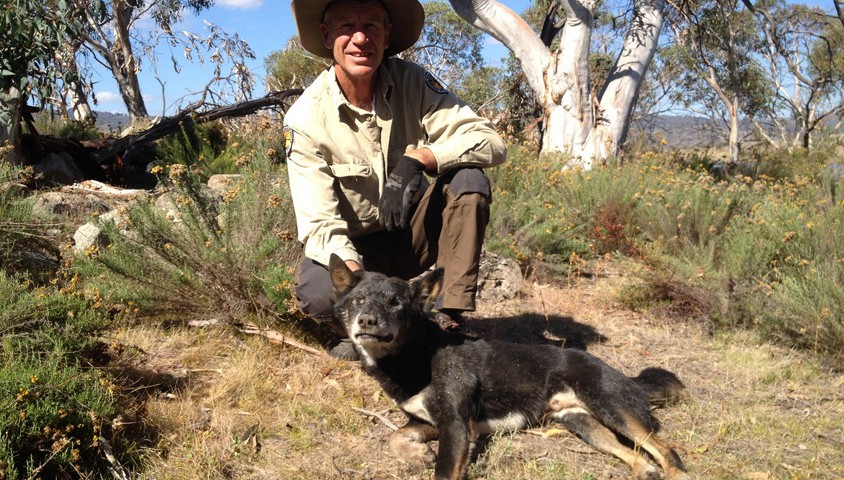This week, the trapping of a wild dog-dingo hybrid has been widely reported in the media, particularly in the rural regions adjacent to Kosciuszko National Park – the area where the animal was active.
In a press release from the NSW National Parks and Wildlife Service (NPWS) that arrived with the subject line ‘National Parks got the dog!’, it was explained that a dog that had ‘terrorised livestock in the Numbla Vale area’ had been trapped after five years of concerted effort.
Last Saturday, March 21, trappers from the NPWS captured the canine using a ‘soft jaw trap’ around three kilometres within Kosciuszko NP, near Stoney Creek. NPWS Area Manager Pam O’Brien has commented on the dog’s unremarkable appearance, which belied its cunning.
“This dog weighed about 30 kilograms and was black with tan and white markings, as many wild dogs are on the Monaro. We estimate the dog was aged between seven and nine years,” she said.
The release also makes mention of an upcoming aerial baiting program, where 1080 will be used to target ‘large tracts of land along the eastern parts of Kosciuszko National Park’.
As such, it appears the NPWS is using this event as a reason to celebrate, going as far as releasing a video of the animal in the lead up to becoming trapped, with media outlets quickly picking up the scent.
‘The killer canine, thought to be a hybrid of domestic breeds and wild dingo, was responsible for hunting down “hundreds” of sheep since 2009 on properties around Numbla Vale,’ wrote Neil Keene and Geoff Chambers for The Daily Telegraph.
Despite the News Corp titles appearing quick to demonise the canine, the story that has been syndicated as far as Perth Now is careful to avoid stating that it is, in fact, a dingo-dog hybrid – a fact that is yet to be clarified by the NPWS, who declined on whether or not genetic analysis had been undertaken when contacted by Wild. In contrast, Fairfax’s John Thistleton alternates between dog and dingo throughout his story on the matter, with little thought given to a potential distinction.
And for the average farmer, the difference between a dog and a dingo matters not, and perhaps there are many hikers, bushwalkers and campers who would agree. For many, packs of wild canines represent a clear and present threat to not only livestock, but also human lives.
This lack of clarification is borne through in the NPWS’s own management policies, which defines a wild dog as ‘any dog living in the wild, including feral dogs, dingos and their hybrids’, thereby becoming fair game for culling.
In contrast, an independent scientific review of Kosciuszko NP’s management practices emphasises the point that this problem is much more complex than is implied by this definition of wild dog, and that perhaps some clemency and scientifically-led practices should be considered.
The review, entitled ‘An assessment of the values of Kosciuszko National Park‘, was produced by 18 independent scientists in 2004 and aims to take in a broad range of research that bears direct relevance to the specific techniques of managing the national park in such a way as to promote the health of the natural environment within while still providing accessible wilderness areas for recreation and adventure activities.
With respect to dingoes, the report highlights the way Australia’s ecosystem has shifted away from a predator hierarchy of natives to one of introduces species.
‘The pre-European predator hierarchy (dingo, Canis familiaris dingo and two quoll species) is highly disrupted and being replaced by a dingo/dog–fox–cat regime. Restoration of the prior regime should be a major priority of management. This will make a major contribution to the conservation of many threatened species. The disruption of the predator regime is likely to have a ‘trophic cascade’ effect on other trophic levels.’
In this context, the ‘wild dogs’ of Kosciuszko NP represent an opportunity to at least attempt to restore some semblance of balance to an environment that is becoming increasingly less native, while providing an opportunity for researchers to understand more about the relationship Australia’s native dog has in the ecosystem.
Our previous profile of Dr Thomas Newsome discusses how studies in the US have increased our understanding of the ecological role of wolves after they were reintroduced into Yellowstone National Park. In some areas, concerns for human safety and livestock losses are overcome with science-led management and public awareness campaigning. Why should this be so different in the case of the dingo?
Of course, there are challenges. Identifying which animals are actually dingoes versus dog-dingo hybrids is the first one. The next will be to create management practices that can actually support dingoes while removing wild dogs or to determine in the first place whether dingo-dog hybrids perform a different ecological role from dingoes. If they perform a similar ecological role, the question of whether or not to remove hybrids becomes a complicated one to answer. Finally, there may be a certain amount of education made feasible for the dingoes themselves, where management practices include programs to deter dingoes from adjacent farms. All these have associated costs in time, resources and labour. But if the eventual outcome is a Kosiuszko NP and surrounds that has less introduced species and therefore more value as a natural heritage site, isn’t that worth a little investment?
We’d like to hear your opinions and experiences regarding wild dogs in the bush. Share a comment below or email us at wild@primecreative.com.au.


